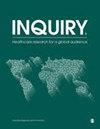Disaster Preparedness for Children With Food Allergies During the 2016 Kumamoto Earthquake—Observational Study
IF 1.7
4区 医学
Q3 HEALTH CARE SCIENCES & SERVICES
Inquiry-The Journal of Health Care Organization Provision and Financing
Pub Date : 2024-04-29
DOI:10.1177/00469580241248100
引用次数: 0
Abstract
A series of 3 direct-type earthquakes with magnitude ≥6 occurred in the Kumamoto Prefecture, located in the western area of Japan, between April 14 and 16, 2016. Children with food allergies (FA) had difficulty procuring allergen-free meals during this period due to the infrastructure shutdown. We investigated the status of children with FA during the 2016 Kumamoto Earthquake and their behavioral changes after the disaster. We conducted a survey of the parents of 59 children with FA (median: 4 years and 1 month old) who were clinically followed up at our institution. They were questioned about their behavior change to allergen removal and using allergen-free foods during the disaster. Forty-seven (79.7%) children with FA were evacuated immediately after the earthquake and returned to their homes after the restoration of lifelines. Most stayed in their cars, while a few took shelter at public evacuation sites. Thirty-eight children (64.4%) had difficulty obtaining allergen-free food, and 29 children with FA (49.2%) did not have a stockpile at home. Thirty-three children with FA (55.9%) consumed allergen-free foods acquired primarily through relief supplies. Forty-seven guardians (79.7%) insisted that stockpiling allergy-friendly foods at home should be a part of future disaster planning. Stockpiles of allergen-free food were not sufficient in most households. Awareness of self-stockpiling allergen-free foods, reassessing public stockpiling, and establishing a system to provide information regarding relief supplies to evacuees outside evacuation centers are important for disaster planning in children with FA.2016 年熊本地震期间食物过敏儿童的防灾准备--观察研究
2016 年 4 月 14 日至 16 日期间,位于日本西部地区的熊本县连续发生了 3 次震级≥6 级的直接型地震。在此期间,由于基础设施关闭,患有食物过敏症(FA)的儿童很难买到无过敏原的膳食。我们调查了患有食物过敏症的儿童在 2016 年熊本地震期间的状况及其在灾后的行为变化。我们对在我院接受临床随访的 59 名 FA 患儿(中位数:4 岁零 1 个月)的父母进行了调查。我们询问了他们在灾难期间清除过敏原和使用无过敏原食物的行为变化。47名(79.7%)患有FA的儿童在地震发生后立即撤离,并在生命线恢复后返回家中。大多数儿童呆在车里,少数儿童在公共疏散点避难。38名儿童(64.4%)难以获得不含过敏原的食物,29名患FA的儿童(49.2%)家中没有储备食物。33名患有FA的儿童(55.9%)主要食用通过救援物资获得的不含过敏原的食物。47 位监护人(79.7%)坚持认为,在家中储备抗过敏食物应该成为未来灾难计划的一部分。大多数家庭的无过敏原食物储备不足。自我储备无过敏原食物的意识、重新评估公共储备以及建立一个向疏散中心外的疏散人员提供救援物资信息的系统,对于患有 FA 的儿童的灾难规划非常重要。
本文章由计算机程序翻译,如有差异,请以英文原文为准。
求助全文
约1分钟内获得全文
求助全文
来源期刊
CiteScore
2.50
自引率
0.00%
发文量
192
审稿时长
>12 weeks
期刊介绍:
INQUIRY is a peer-reviewed open access journal whose msision is to to improve health by sharing research spanning health care, including public health, health services, and health policy.

 求助内容:
求助内容: 应助结果提醒方式:
应助结果提醒方式:


